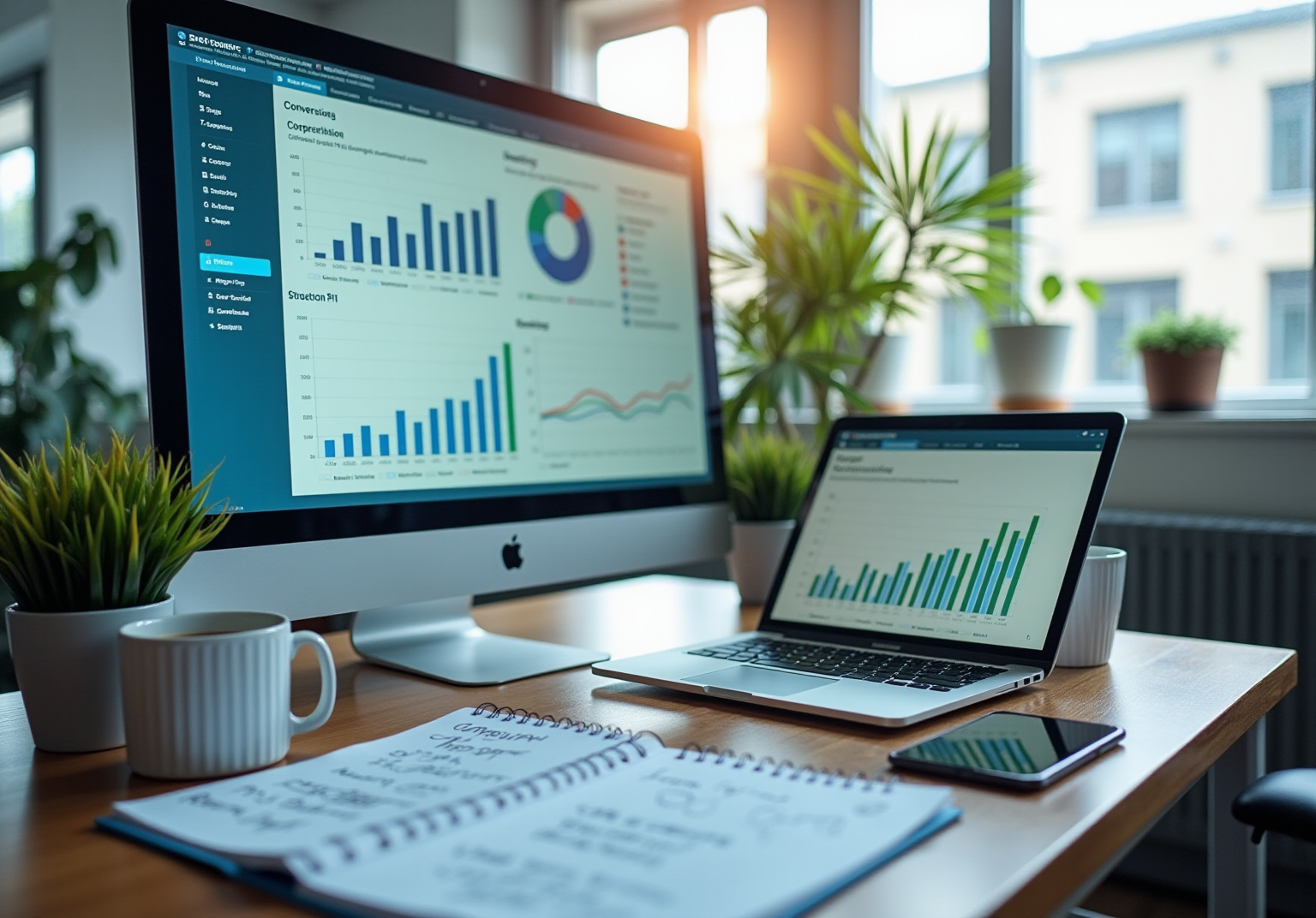
Overview
This article examines the pivotal role of integrated PPC (Pay-Per-Click) and SEO (Search Engine Optimization) strategies in enhancing profitability for direct-to-consumer (DTC) brands. By showcasing compelling case studies, it highlights significant increases in conversion rates and average order values.
A cohesive approach that leverages both strategies not only maximizes visibility but also minimizes customer acquisition costs—an essential factor for success in today's competitive market.
DTC brands that implement these integrated strategies are well-positioned to thrive, demonstrating the critical need for a unified marketing approach.
Introduction
In the fiercely competitive digital marketplace, direct-to-consumer (DTC) brands are increasingly recognizing the pivotal importance of integrated marketing strategies. By harmonizing pay-per-click (PPC) advertising with search engine optimization (SEO), these companies unlock new avenues for profitability and visibility. Yet, as customer acquisition costs continue to rise, the pressing challenge remains: how can DTC brands effectively balance immediate results with sustainable growth? This article explores seven critical insights that illuminate the dynamic interplay between PPC and SEO, offering actionable strategies for brands striving to thrive in a rapidly evolving landscape.
Parah Group: Enhancing DTC Brand Profitability through Integrated PPC and SEO Strategies
stands at the forefront of enhancing profitability for through the strategic integration of . By leveraging and principles of consumer psychology, the agency crafts customized marketing solutions that amplify visibility and optimize . This cohesive strategy guarantees that every marketing dollar is utilized efficiently, a crucial factor for DTC companies facing rising .
Successful DTC companies illustrate the efficacy of this integrated approach. For example, a $30M apparel company collaborated with Parah Group to tackle low conversion rates. Through redesigning their homepage to emphasize social proof, optimizing product pricing, and incorporating gamified elements, they achieved an impressive 35% alongside a 10% boost in revenue per visitor. Similarly, Grab Green, a $15M cleaning product brand, experienced an 80% increase in average order value (AOV) by experimenting with free shipping thresholds and offering bundles, showcasing the success of tailored strategies.
Marketing experts underscore the importance of data-driven insights in optimizing PPC & SEO efforts. As noted, combining PPC & SEO strategies is a powerful way to enhance the impact of your digital marketing efforts. This perspective highlights the significance of a , which not only elevates overall search visibility but also deepens understanding of audience search behavior.
DTC companies increasingly embrace , employing keyword research to inform both PPC & SEO campaigns. This synergy allows companies to capitalize on high-traffic keywords while simultaneously enhancing their organic search visibility. By aligning their strategies for PPC & SEO initiatives, companies can effectively reduce acquisition costs and enhance profitability, ensuring that no lead is overlooked in the conversion process.
In conclusion, the integration of PPC & SEO strategies is not merely beneficial; it is essential for DTC companies striving to thrive in a competitive landscape. By focusing on data-driven insights and maintaining a consistent identity across channels, companies can achieve sustainable growth and improved profitability, as evidenced by the successful outcomes from Parah Group's case studies.
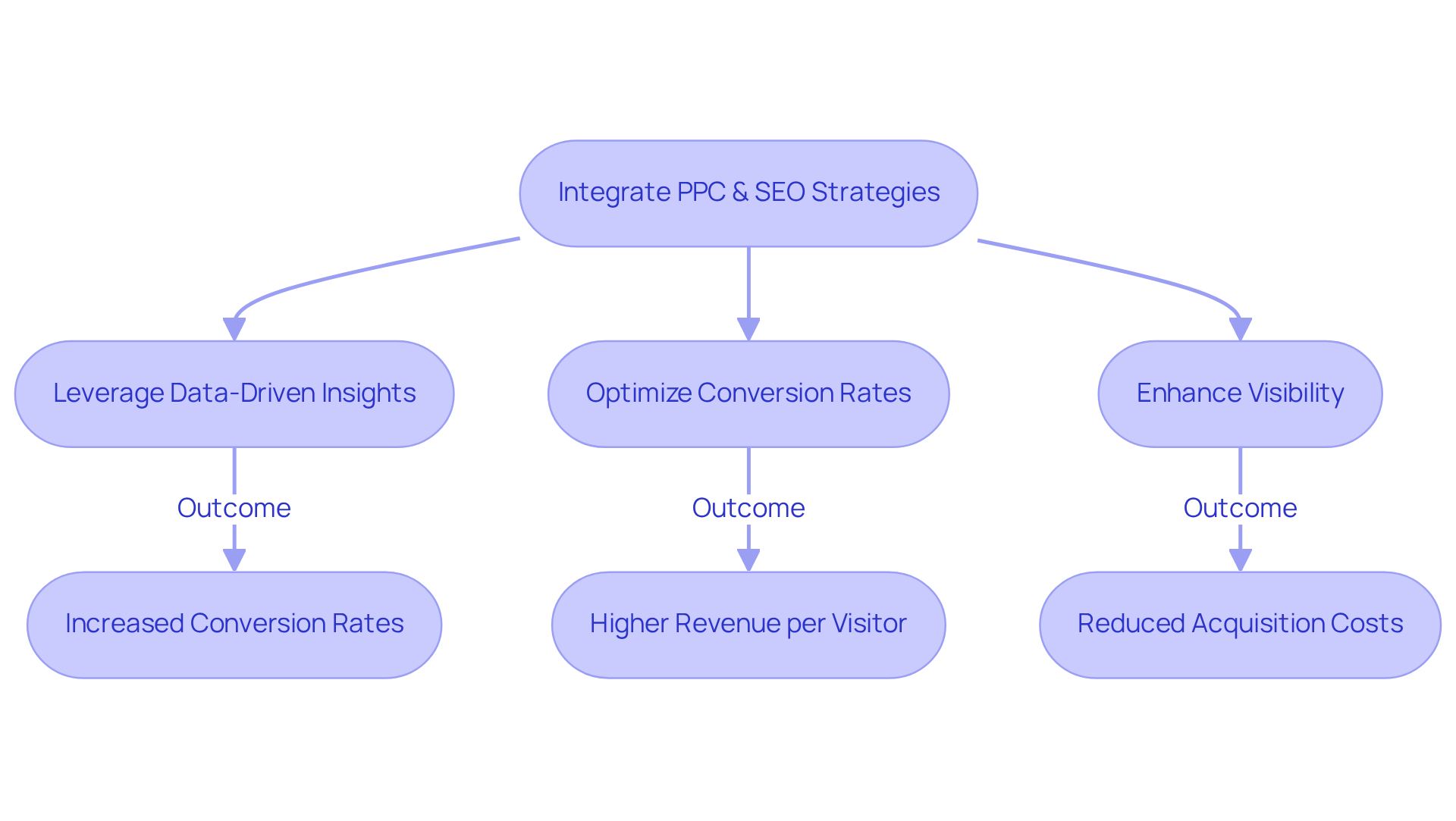
PPC vs. SEO: Understanding Cost Structures and Investment Requirements
Pay-per-click (PPC) advertising demands a continuous investment, as companies incur costs for each click on their ads. This approach offers but comes with ongoing expenses. In contrast, necessitates an initial investment for content creation and optimization. However, once established, SEO can generate without the burden of continual costs. Understanding this distinction is vital for companies seeking to effectively and achieve through strategies like .
For instance, SEO can yield a minimum of 500% over a period of 6 to 12 months, while PPC ads typically yield an average ROI of 200%. This comparison underscores the , despite its slower initial returns. Furthermore, organic search accounts for over 53% of website traffic across various sectors, with the leading organic search result attracting 39.8% of clicks, compared to only 2.1% for the first paid advertisement. Thus, investing in SEO significantly enhances an entity's online visibility without the recurring expenses associated with PPC campaigns.
It is essential to recognize that SEO generally requires 3 to 6 months of consistent effort to produce results, making it a time-intensive and laborious process. By comprehending these cost frameworks, DTC companies can make informed decisions about their marketing strategies, effectively balancing the need for immediate visibility through PPC and SEO with the potential for long-term growth.
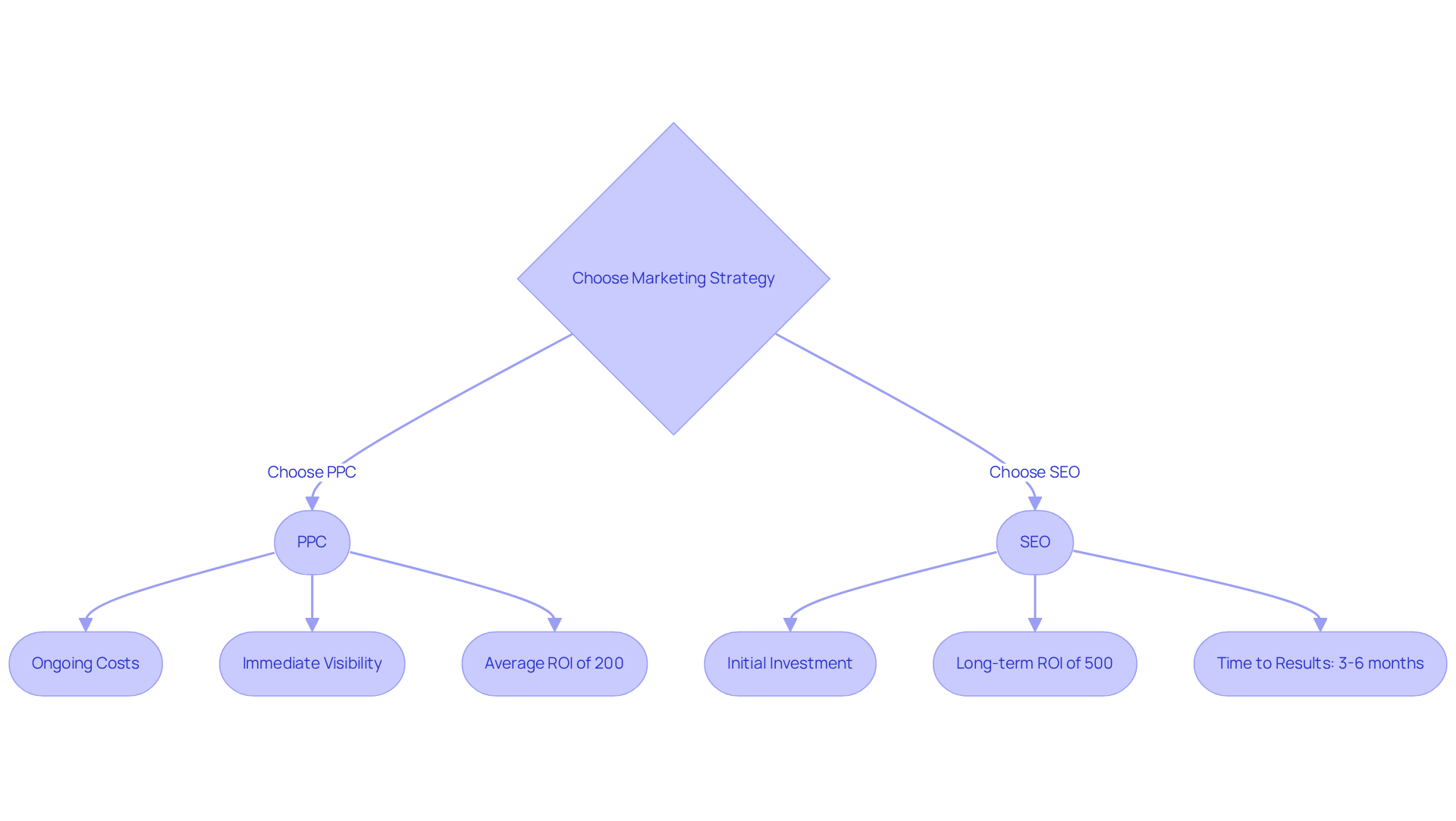
Time to Results: Immediate Impact of PPC vs. Long-Term Gains from SEO
PPC campaigns are widely recognized for their capacity to deliver , often generating traffic and conversions within days of launch. This rapid impact renders PPC particularly appealing for companies aiming for quick wins, especially during product launches or seasonal promotions. Conversely, SEO represents a that typically necessitates several months to yield significant results. However, the can provide lasting benefits, establishing a sustainable influx of visitors and bolstering company credibility over time.
Digital marketing experts assert that while PPC can drive immediate sales, the are invaluable; businesses prioritizing SEO frequently experience a and reduced . For instance, case studies reveal that brands investing in SEO indicate that a substantial share of their revenue originates from organic search, with a close rate of 14.6% for SEO-driven leads compared to only 1.7% for outbound marketing methods.
involves , thereby transforming more visitors into customers. By incorporating CRO strategies, such as and improvements in user experience, the efficiency of initiatives in both PPC & SEO can be significantly enhanced. Therefore, into a marketing strategy, alongside a robust CRO approach, not only maximizes visibility but also ensures a balanced pathway to profitability.
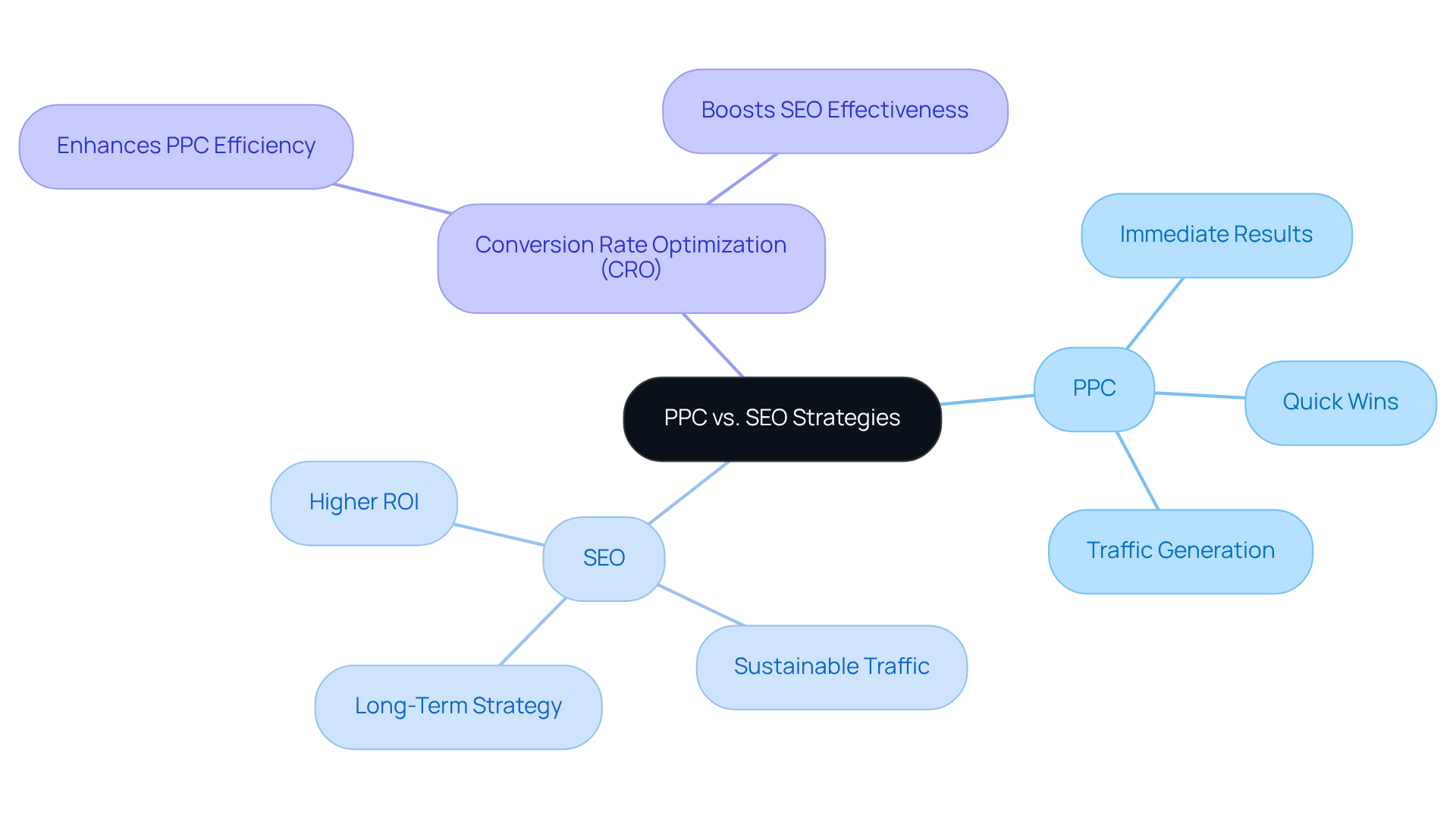
Targeting Capabilities: Precision of PPC vs. Organic Reach of SEO
with precise targeting capabilities, enabling them to engage specific demographics, interests, and behaviors through platforms like Google Ads and social media. This focused strategy significantly amplifies the probability of conversions, delivering ads to the most pertinent audiences.
Conversely, through . While SEO may not offer the immediate accuracy of PPC, can progressively draw a broader audience, enhancing company authority and trust over time.
Indeed, statistics reveal that , highlighting its critical role in DTC marketing. As businesses increasingly prioritize sustainable growth, the and organic benefits becomes indispensable for .
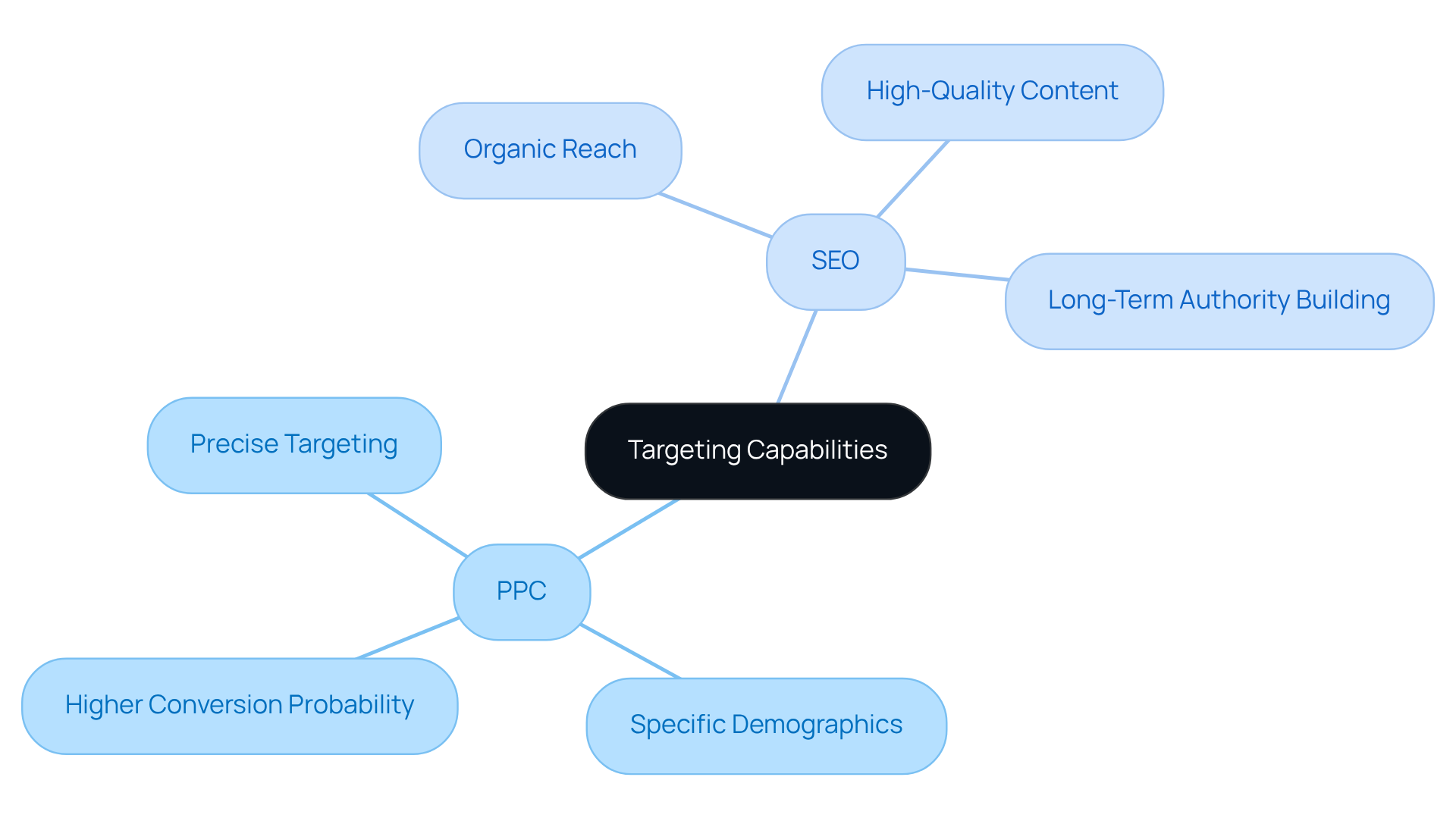
Sustainability and Impact: Evaluating Long-Term Viability of PPC and SEO
PPC can deliver immediate traffic; however, its sustainability is hindered by continuous costs and intense competition for ad space. Once a budget is depleted, visibility disappears, rendering it a short-term solution. In contrast, SEO establishes a foundation for enduring growth by generating organic traffic that produces results without ongoing expenses. Brands prioritizing SEO can experience , with studies indicating that a single high-ranking page can attract consistent traffic for years. This positions SEO as a more viable choice for , as it not only reduces customer acquisition costs but also enhances authority and trust.
For instance, DTC companies investing in SEO have reported , with some achieving over 10,000 monthly visitors within a year. This strategic focus on SEO not only fosters but also gives companies a competitive edge in an increasingly crowded market.
Moreover, transformational case studies from illustrate how innovative CRO strategies have driven revenue growth for DTC companies. For example, a $30M apparel company experienced a 35% increase in conversion rates after implementing a redesigned homepage that showcased social proof and optimized pricing. Similarly, a $15M cleaning product line enhanced its average order value by 80% through strategic bundling and pricing tests.
These outcomes underscore the importance of integrating , as companies leveraging both PPC & SEO approaches can and strengthen their market position.
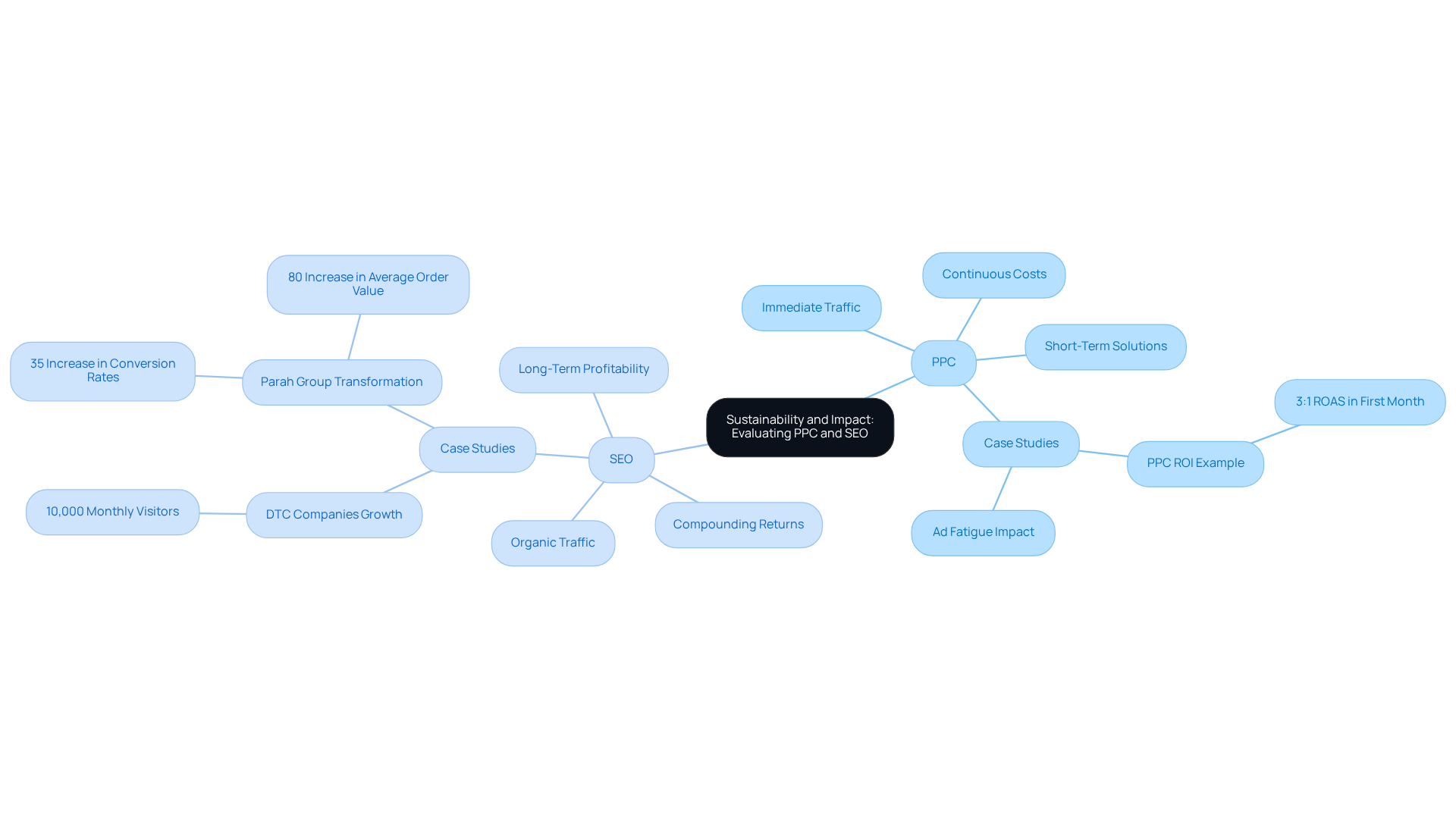
Measurement and Analytics: Tracking Success in PPC vs. SEO
that empower companies to monitor (KPIs) such as click-through rates (CTR), , and return on ad spend (ROAS) in real-time. This immediate access to data facilitates rapid adjustments, for peak effectiveness. In contrast, depends on metrics like organic traffic, keyword rankings, and engagement rates. Although SEO analytics may require more time to yield visible results, they deliver vital insights into , essential for shaping future optimization strategies.
For instance, companies like Vessi have successfully tracked their SEO successes by analyzing user engagement and the increase in organic traffic, directly linked to their innovative promotional strategies. By 2025, will encompass not only traditional indicators but also advanced analytics that evaluate user behavior across various touchpoints.
Digital marketing analysts stress the importance of a balanced approach, emphasizing that while PPC & SEO offer immediate results, the are irrefutable. As Trevor Testwuide, CEO of Measured, asserts, for optimal outcomes, underscoring the necessity for a comprehensive measurement strategy that integrates PPC & SEO.
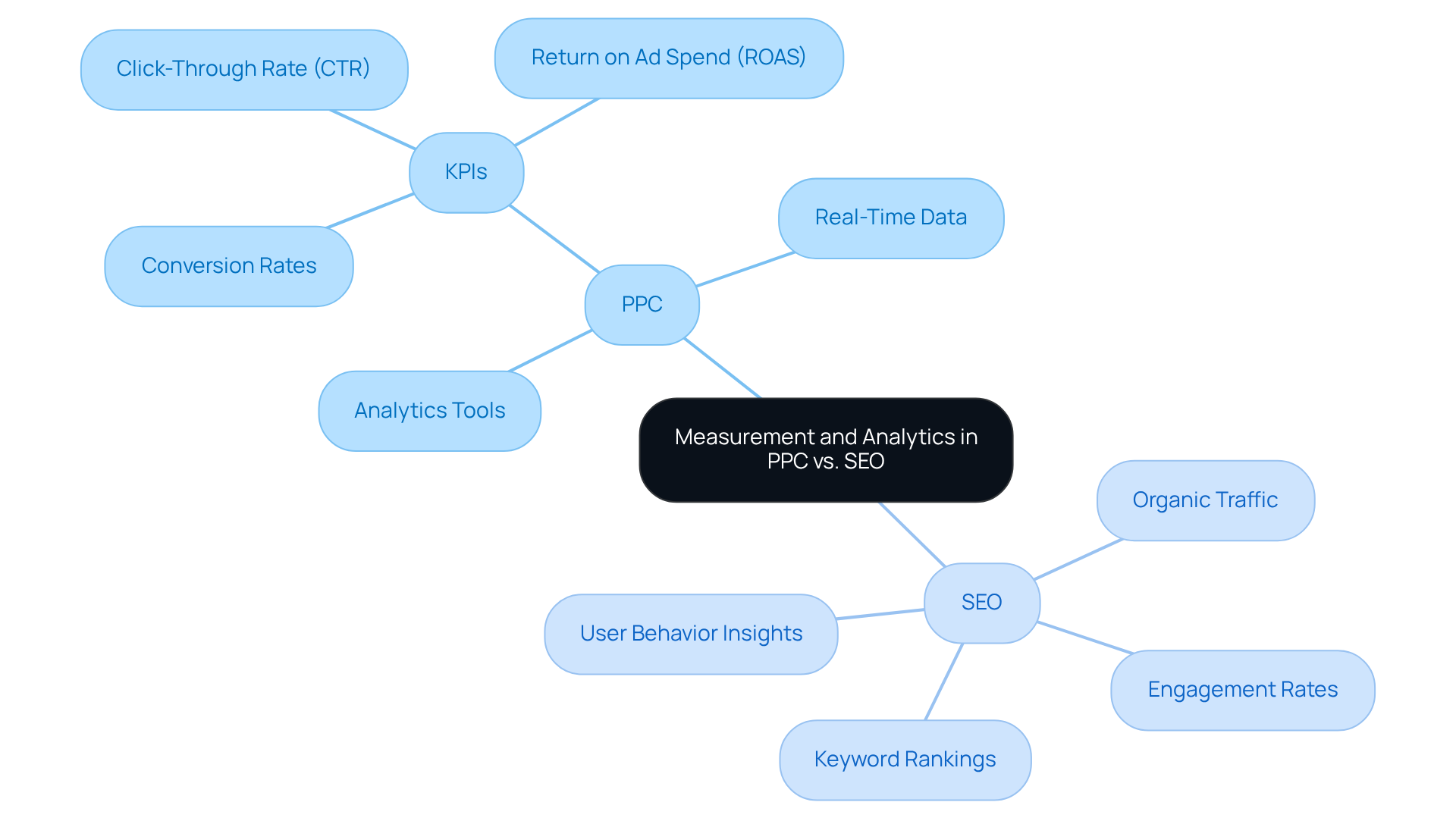
Pros and Cons: Weighing the Benefits and Drawbacks of PPC and SEO
PPC offers instant visibility, precise targeting, and measurable outcomes, positioning it as a compelling option for businesses aiming for swift traffic boosts. For every $1 invested in Google Ads, companies can expect a remarkable , underscoring the potential ROI inherent in PPC. However, it necessitates , and many organizations experience ad fatigue, where the effectiveness of ads diminishes over time due to excessive exposure. This fatigue can profoundly , making it crucial for businesses to vigilantly monitor their campaigns.
Conversely, SEO fosters , enhances credibility, and is typically more cost-effective over time. Nevertheless, it requires substantial initial effort and time—often taking four to six months to produce significant results.
As DTC companies navigate these strategies in 2025, they must judiciously evaluate their unique circumstances, considering factors such as budget, competitive landscape, and the potential for ad fatigue in their . Marketing experts stress the ; as Palmer articulates, 'While you are working on growing your organic traffic, you can leverage PPC & SEO to bring in revenue in the short term.' This dual strategy not only maximizes profitability but also alleviates risks associated with an over-reliance on a singular channel.
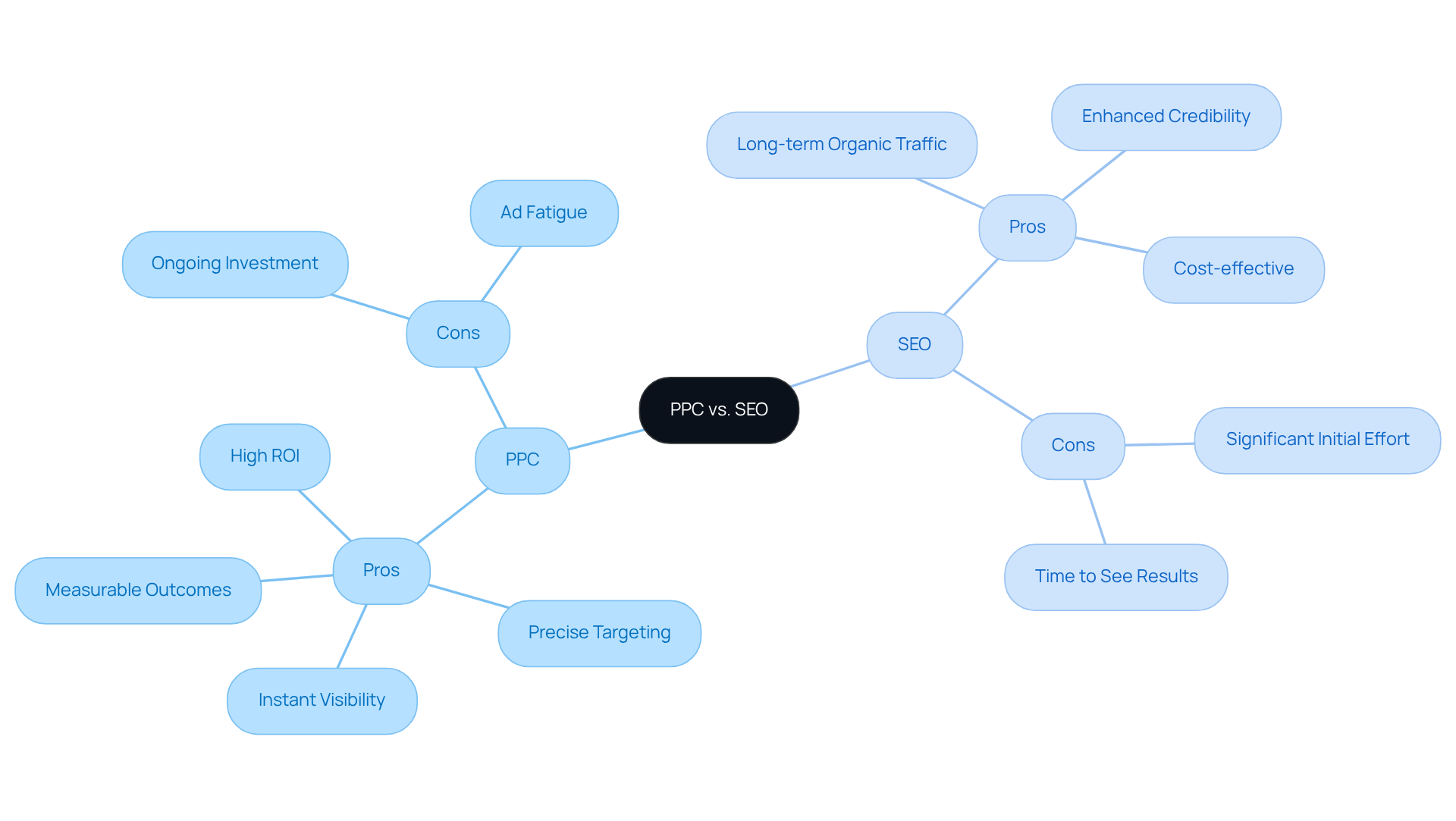
Complementary Strategies: How PPC Enhances SEO Efforts for DTC Brands
The integration of PPC & SEO creates a formidable marketing synergy that is particularly beneficial for . SEO cultivates organic visibility over time, while PPC delivers immediate traffic, ensuring that companies maintain their presence as their take root. For example, campaigns that merge SEO-centric content with continuous PPC efforts have yielded an impressive 55% , underscoring the potency of this dual strategy.
Insights derived from —such as high-performing keywords and user behavior trends—are vital for refining SEO tactics. By harnessing PPC data, companies can tailor their content to resonate with their audience, thereby . This complementary approach not only amplifies marketing effectiveness but also supports sustainable growth.
Numerous successful cases illustrate the impact of effectively leveraging both PPC and SEO. For instance, enabled a $30M clothing brand to achieve a 35% rise in conversion rates through strategic homepage redesigns, optimized pricing, and enhanced social proof. Similarly, a $15M cleaning product brand experienced an 80% increase in average order value by implementing bundles and establishing free shipping thresholds, showcasing how targeted strategies can enhance profitability.
Marketing experts emphasize that the is essential for [DTC companies](http://parahgroup.com/blogs/8-key-strategies-to-optimize-your-purchasing-funnel-for-dtc-brands) facing competitive challenges. By securing both paid and organic placements, companies can dominate search engine results pages (SERPs), significantly increasing their potential to capture user attention and drive conversions. This comprehensive approach not only builds authority but also enriches user experience, ultimately resulting in and improved profitability.

Competitive Landscape: Navigating PPC and SEO in a Crowded Market
In the fiercely competitive , companies encounter the formidable challenge of distinguishing themselves amidst a plethora of options. advertising presents a swift avenue for securing prominent ad placements in search results; however, the intensifying competition often results in escalating costs. Conversely, may require a longer timeframe to yield results, yet it fosters a robust organic presence that can effectively differentiate companies from their competitors. By strategically , companies can markedly enhance their visibility and engagement, ensuring they capture consumer attention in this crowded landscape.
Industry specialists assert that a dual strategy not only maximizes reach but also establishes . As PPC expenses continue to rise—with over $150 billion invested annually in paid search in the U.S.—companies must leverage PPC & SEO to over time. Successful DTC brands have illustrated that by harnessing insights from both PPC & SEO channels, they can create a that drives and profitability. For instance, businesses that have effectively merged their PPC & SEO techniques report and overall market share, underscoring the efficacy of an integrated digital marketing approach. Dr. Ali Jaffar Zia observes, 'We've seen the best results when PPC & SEO data drives content planning,' highlighting the critical importance of integrating these two strategies for optimal outcomes.
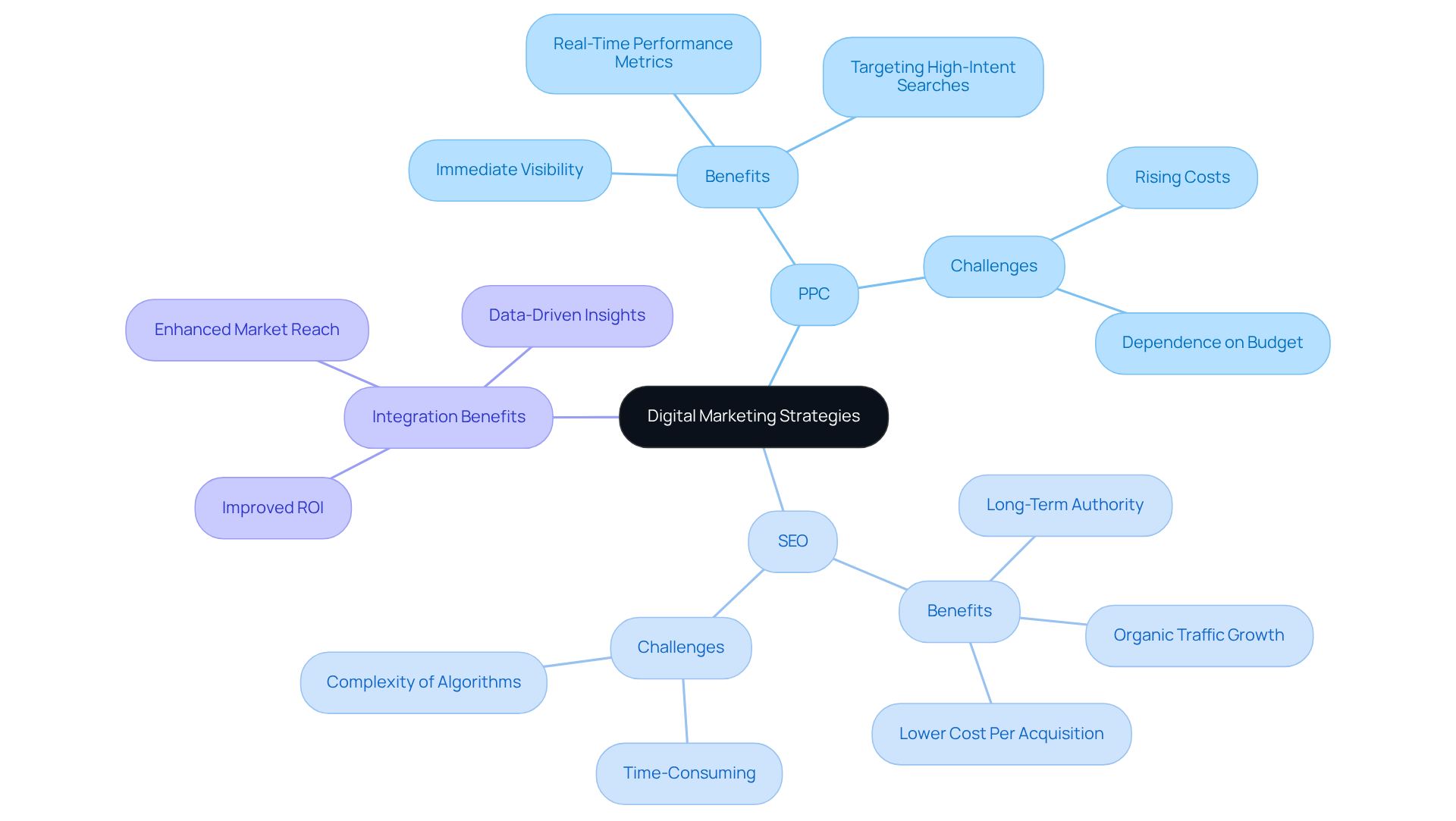
Adapting to Change: Evolving PPC and SEO Strategies for DTC Brands
In today's rapidly changing digital landscape, companies must proactively refine their strategies to maintain relevance and drive profitability. Adopting emerging technologies, particularly , is essential for optimizing ad targeting and enhancing campaign performance. AI tools analyze real-time performance data, enabling companies to swiftly and effectively adjust their marketing efforts. For instance, AI-driven insights empower marketers to predict which creative combinations and audience segments yield the highest returns, significantly (ROAS).
Furthermore, prioritizing is critical for improving organic rankings. Research consistently shows that a seamless user experience directly correlates with , as search engines favor sites that engage visitors effectively, which is crucial for both PPC & SEO. DTC companies should routinely , ensuring fast loading times and intuitive navigation to meet the increasing expectations of consumers.
Staying abreast of industry trends and is equally vital. Experts emphasize that companies monitoring these changes can refine their strategies to better resonate with their target audiences. For example, with 60% of Amazon's monthly visits originating from mobile devices, optimizing for has become imperative. By adapting to these dynamics, DTC brands can not only elevate their visibility but also cultivate deeper connections with their customers, ultimately driving sustained growth and profitability.
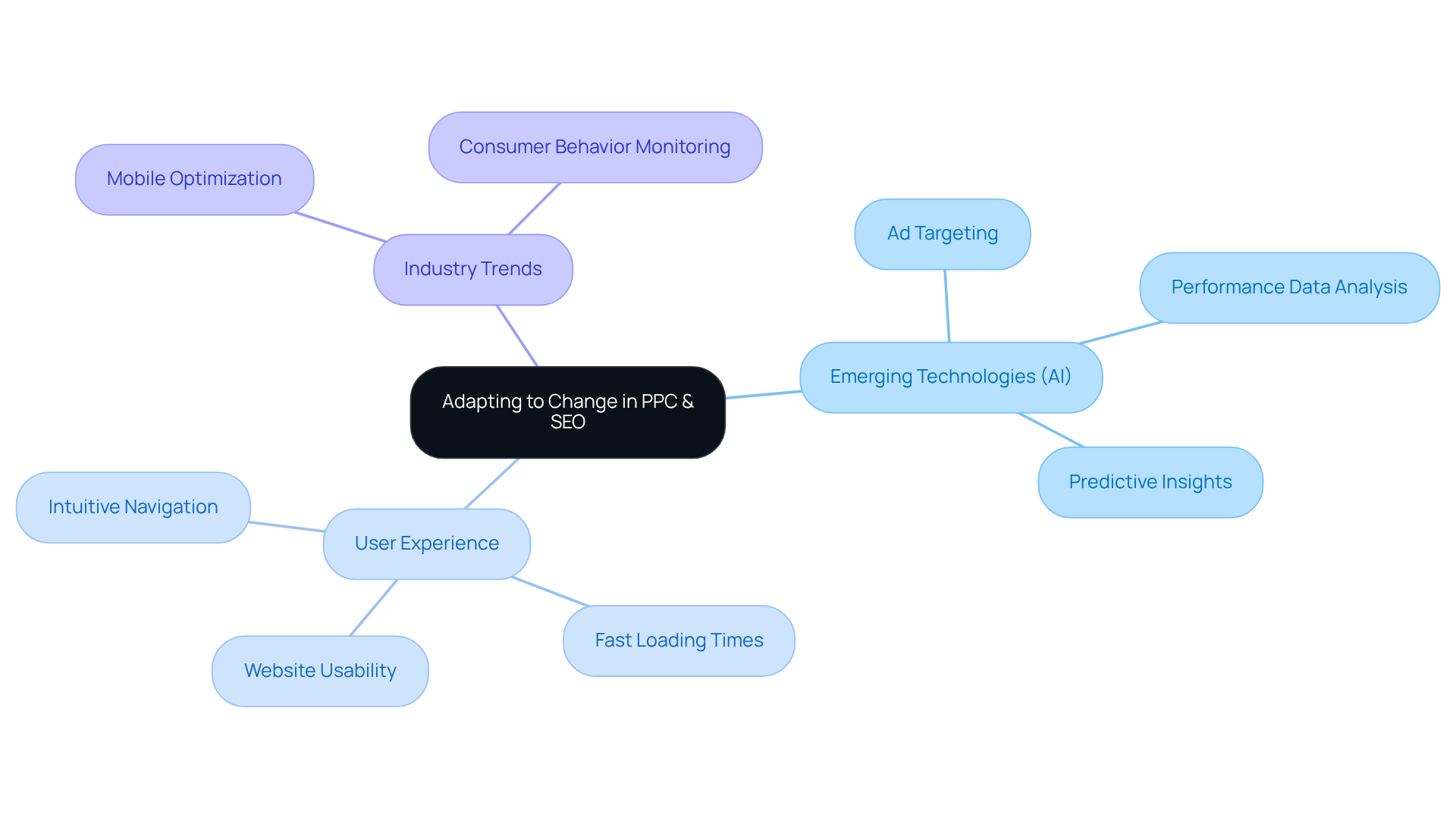
Conclusion
The integration of PPC and SEO strategies stands as a pivotal element for DTC brands aiming to enhance profitability and secure a competitive edge. By leveraging these two formidable marketing approaches in unison, companies can optimize visibility, lower customer acquisition costs, and ultimately drive sustainable growth. This cohesive strategy not only maximizes immediate returns through PPC but also lays a robust foundation for long-term success via SEO.
Key insights throughout the article underscore the distinct advantages of both PPC and SEO:
- PPC delivers immediate visibility and precise targeting, rendering it an effective tool for achieving quick wins.
- Conversely, SEO cultivates organic reach and credibility over time, often resulting in higher returns on investment.
- Successful case studies, such as those from Parah Group, exemplify how tailored strategies that merge both approaches can lead to substantial increases in conversion rates and average order values, thereby reinforcing the necessity of a balanced marketing strategy.
In an increasingly dynamic digital landscape, DTC brands must remain agile and responsive. Embracing the synergy between PPC and SEO, while adapting to emerging trends and consumer behaviors, will be essential for driving profitability in 2025 and beyond. By prioritizing integrated strategies, companies can not only enhance their market presence but also foster enduring relationships with their customers, ensuring a robust and sustainable business model.
Frequently Asked Questions
What is the main focus of Parah Group?
Parah Group focuses on enhancing profitability for direct-to-consumer (DTC) businesses through the integration of PPC (pay-per-click) and SEO (search engine optimization) strategies.
How does Parah Group utilize data-driven insights?
Parah Group leverages data-driven insights and consumer psychology principles to create customized marketing solutions that improve visibility and optimize conversion rates for DTC companies.
Can you provide an example of a successful collaboration with Parah Group?
One example is a $30M apparel company that worked with Parah Group to improve low conversion rates. They redesigned their homepage, optimized product pricing, and added gamified elements, resulting in a 35% increase in conversion rates and a 10% increase in revenue per visitor.
What was the outcome for Grab Green after working with Parah Group?
Grab Green, a $15M cleaning product brand, achieved an 80% increase in average order value (AOV) by testing different free shipping thresholds and offering bundles.
Why is combining PPC and SEO strategies important?
Combining PPC and SEO strategies enhances the effectiveness of digital marketing efforts, improves overall search visibility, and helps businesses understand audience search behavior better.
How do DTC companies utilize keyword research?
DTC companies employ keyword research to inform both their PPC and SEO campaigns, allowing them to target high-traffic keywords while improving organic search visibility.
What are the cost structures associated with PPC and SEO?
PPC requires continuous investment for each ad click, providing immediate visibility but ongoing costs. In contrast, SEO requires an initial investment for content creation and optimization, but can generate organic traffic without continuous expenses once established.
What is the expected return on investment (ROI) for SEO compared to PPC?
SEO can yield a minimum ROI of 500% over 6 to 12 months, while PPC typically yields an average ROI of 200%, highlighting the long-term benefits of SEO.
How long does it usually take for SEO to show results?
SEO generally requires 3 to 6 months of consistent effort to produce significant results, making it a time-intensive process.
What are the immediate impacts of PPC compared to the long-term gains from SEO?
PPC campaigns can deliver immediate results, generating traffic and conversions within days, while SEO is a long-term strategy that builds sustainable traffic and credibility over time.
How does Conversion Rate Optimization (CRO) relate to PPC and SEO?
CRO involves enhancing websites to increase conversions, which can improve the efficiency of both PPC and SEO initiatives. Integrating CRO with PPC and SEO maximizes visibility and profitability.
FAQs











